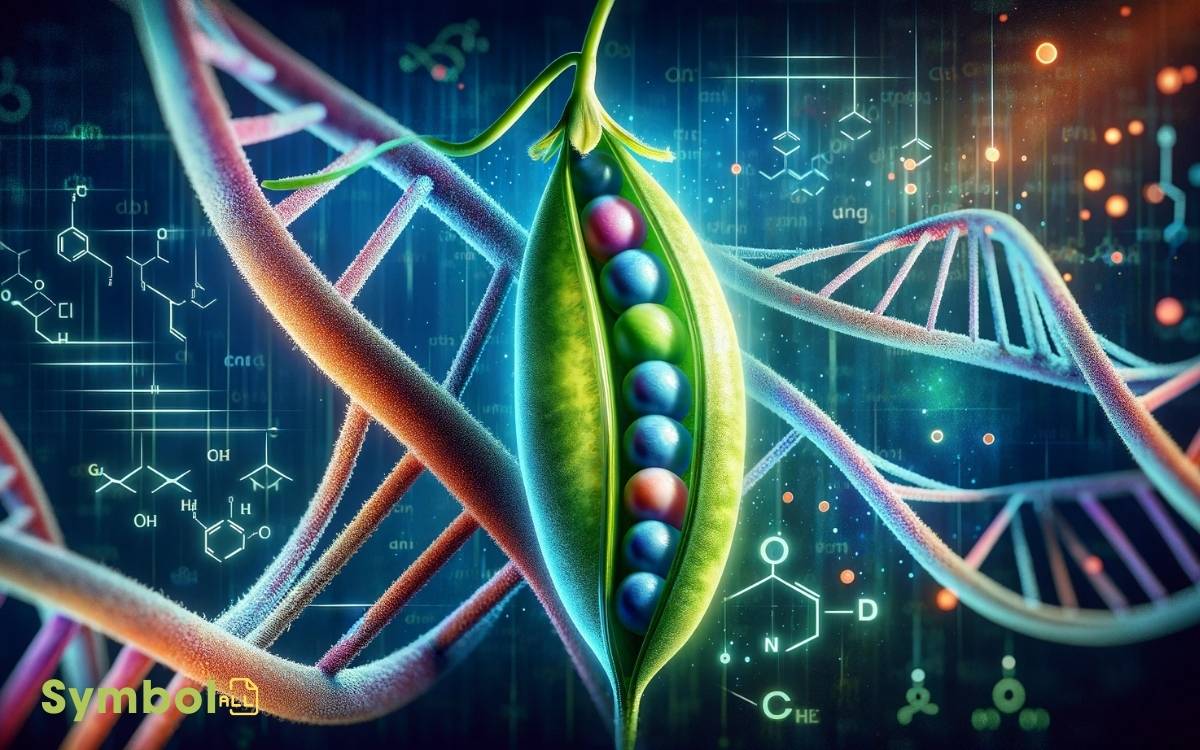What Symbol Represents the Recessive Allele for Pod Color?
In genetics, the symbol that represents the recessive allele for pod color is a lowercase letter. You must remember that alleles are specific versions of genes, contributing to varying traits.
While dominant alleles mask the expression of recessive alleles, a recessive allele requires two copies for its trait to manifest.
This distinction is vital for understanding inheritance patterns, particularly in Gregor Mendel‘s foundational pea plant experiments.
Using lowercase letters to denote recessive traits is a fundamental aspect of genetic notation. It’s essential for accurately predicting genetic outcomes, including those related to pod color in pea plants.

Key Takeaway
Understanding Genetic Symbols
In genetics, symbols serve as shorthand notations to represent the attributes of genes, such as dominant or recessive traits, enabling precise communication and analysis of inherited characteristics.
You’re venturing into a domain where clarity and precision are paramount. Understanding these symbols is foundational, akin to learning an intricate, specialized language.
Symbols, often letters, denote specific genes and their variants. A capital letter typically represents a dominant trait, while a lowercase letter signifies a recessive trait.
This convention simplifies the depiction of how traits are passed from one generation to the next. Grasping this symbolic language allows you to accurately predict genetic outcomes, fostering a deeper comprehension of biological inheritance.
It’s essential, especially when analyzing complex genetic crosses, to rely on these symbols for a structured and error-free representation of genetic information.
The Basics of Alleles
Building on your understanding of genetic symbols, it’s crucial to explore alleles, which are the specific versions of a gene that contribute to varying traits.
Fundamentally, each gene resides at a specific locus on a chromosome and can exist in multiple forms; these forms are alleles.
They’re vital for genetic diversity within a population, influencing everything from pod color in plants to eye color in humans.
Your DNA contains two alleles for each gene, one inherited from each parent. These alleles can be identical or different, depending on the combination you receive.
Understanding alleles is foundational in genetics, allowing you to grasp how traits are passed through generations and how genetic variation occurs.
This knowledge is pivotal when analyzing specific traits, such as pod color in plants.
Dominant Vs Recessive
Understanding the distinction between dominant and recessive alleles is vital as they determine the manifestation of traits in organisms.
When you’re delving into genetics, it’s important to grasp these concepts:
- Dominant alleles mask the expression of recessive alleles when both are present.
- Recessive alleles require two copies (one from each parent) to exhibit the trait.
- Alleles are represented by letters; dominant alleles are usually denoted by uppercase letters, while recessive alleles by lowercase.
- The presence of a dominant allele results in the dominant phenotype, even if the recessive allele is present.
- Homozygous organisms have two identical alleles for a trait, while heterozygous organisms have one dominant and one recessive allele.
This understanding is foundational in predicting how traits will pass from parents to offspring.
The History of Pea Plants
You must understand that the history of pea plants is pivotal in genetics, primarily due to Gregor Mendel‘s experiments.
His work laid the groundwork for the principles of genetic inheritance, revealing how traits are passed from one generation to the next.
Analyzing Mendel’s methodology provides essential insights into the foundation of modern genetics, including the distinction between dominant and recessive alleles.
Gregor Mendels Experiments
In the mid-19th century, Gregor Mendel conducted groundbreaking experiments with pea plants, laying the foundation for the modern understanding of genetics.
Through meticulous cross-breeding, he observed patterns of inheritance, leading to significant insights.
Consider these critical aspects of Mendel’s work:
- Controlled Cross-Pollination: Mendel manually pollinated plants to control their genetic combinations.
- Trait Selection: He chose seven easily distinguishable traits, including pod color, to study.
- Generational Study: Mendel’s analysis spanned multiple generations, allowing him to observe patterns over time.
- Quantitative Approach: He meticulously counted and categorized offspring, applying statistical analysis.
- Reproducibility: Mendel’s experiments were designed to be repeatable, ensuring the reliability of his findings.
Mendel’s painstaking work set the stage for the discovery of genes, revolutionizing biology and genetics.
Genetic Inheritance Principles
Delving into the history of pea plants reveals that Mendel’s discovery of genetic inheritance principles fundamentally transformed our grasp of heredity.
Through meticulous experimentation, he identified that traits aren’t blended but are passed through discrete units, now known as genes.
Mendel’s laws of segregation and independent assortment articulate how alleles, the different forms of a gene, segregate during gamete formation and assort independently across traits.
This implies that the inheritance of one trait’s allele doesn’t influence the inheritance of another, allowing for important genetic variations.
His work, initially overlooked, now underpins genetic studies, enabling you to understand the mechanisms driving inheritance.
This foundation is essential for grasping how recessive and dominant alleles, such as those determining pod color, interact within organisms.
Gregor Mendels Experiments
Gregor Mendel’s groundbreaking experiments meticulously dissected the inheritance patterns of pea plants, revealing the foundational principles of genetics.
His methodical approach uncovered the predictable ways traits are transmitted from parents to offspring, setting the stage for modern genetics.
To grasp Mendel’s innovative work, consider these key points:
- Selection of Pea Plants: He chose pea plants for their distinct, easily identifiable traits.
- Controlled Cross-Pollination: Mendel manually pollinated the plants to control their mating.
- Purebred Lines: He established pure lines to guarantee consistent trait inheritance.
- Generation Tracking: Mendel meticulously tracked traits across multiple generations.
- Statistical Analysis: Utilizing mathematical analysis, he interpreted the patterns of inheritance.
This analytical, precise approach allowed Mendel to deduce the existence of dominant and recessive alleles, though he didn’t use these exact terms.
Decoding Pod Color Genetics
Understanding pod color genetics in pea plants requires a thorough exploration of Mendel’s discovery of recessive and dominant alleles.
You’ll find that pod color, like many genetic traits, is influenced by these alleles, which are variations of a gene.
Recessive alleles for pod color only express themselves in the phenotype when two copies are present, meaning the plant inherits one from each parent.
Conversely, a significant allele will express its trait even if only one copy is present. This distinction is vital for predicting the pod color of offspring in pea plants.
Symbolism in Genetic Notation
In genetic notation, symbols play a crucial role in representing the recessive and dominant alleles that determine traits like pod color in pea plants. These symbols allow geneticists to efficiently communicate complex inheritance patterns. For example, uppercase letters often denote dominant alleles, while lowercase letters represent recessive ones. Similarly, tools like the color vowel chart IPA symbols can be used in linguistics to convey precise sounds, offering a parallel to the clarity provided by genetic notation.
You’ll find that this symbolic language is both precise and technical, tailored for clarity and quick comprehension.
- Dominant alleles are denoted by uppercase letters (e.g., ‘G’ for green pod color).
- Recessive alleles use lowercase letters (e.g., ‘g’ for yellow pod color).
- Homozygous conditions are indicated by either two uppercase or two lowercase letters (GG or gg).
- Heterozygous genotypes feature one of each letter type (Gg), signifying the presence of both alleles.
- Phenotype vs. Genotype: Symbols primarily denote genotype, which in turn influences the observable phenotype.
This notation system guarantees that genetic information is transmitted succinctly and accurately, allowing for effective communication and analysis within the scientific community.
The Recessive Allele Explained
You must grasp that recessive alleles only express their traits when paired with another recessive allele, contrasting with dominant alleles that can manifest in the presence of a recessive partner.
This concept is foundational to understanding genetic representation, where symbols denote the presence of dominant or recessive genes.
Consequently, the interplay between dominant and recessive genes elucidates the underlying mechanisms of inheritance and phenotype expression.
Understanding Recessive Alleles
A recessive allele requires two copies, one from each parent, to exhibit its trait in an organism’s phenotype. This genetic mechanism underpins many traits observable in various species, including humans.
To deepen your understanding, consider these key points:
- Recessive alleles are masked by dominant alleles unless present in homozygous pairs.
- They can carry traits that may not visibly affect the phenotype until combined with another recessive allele.
- Genetic carriers possess one recessive allele, potentially passing it to offspring without showing any trait signs.
- Environmental factors usually don’t influence the expression of recessive alleles; their manifestation is purely genetic.
- Recessive alleles contribute to genetic diversity and can sometimes offer evolutionary advantages under specific conditions.
Understanding these concepts is essential for anyone aiming to comprehend genetic inheritance patterns and their implications on organism traits.
Genetic Representation Basics
To grasp the intricacies of genetic inheritance, it’s important to understand how recessive alleles are symbolically represented in genetics. Typically, letters are used as symbols, with lowercase letters denoting recessive alleles.
This choice isn’t arbitrary; it reflects a fundamental principle in genetics, where dominant traits are represented by uppercase letters, and their recessive counterparts by lowercase.
For pod color, if the dominant allele is symbolized by ‘G’ for green, then the recessive allele, perhaps representing yellow, would be notated as ‘g’.
This system allows for clear, concise communication of genetic makeup. It’s essential you’re familiar with this notation, as it’s the bedrock for genetic diagrams, predictions, and understanding inheritance patterns.
Mastery of these symbols equips you with the ability to decode and predict genetic outcomes accurately.
Dominant Vs. Recessive Genes
Having established how recessive alleles are symbolized, it’s important to understand the underlying mechanisms that differentiate dominant from recessive genes.
Here’s a concise exploration:
- Expression: Dominant genes mask the effects of recessive genes when both are present.
- Homogeneity: Recessive traits appear only in homozygous pairings, requiring two copies for expression.
- Phenotypic Ratio: Crosses involving recessive alleles often result in a 3:1 phenotypic ratio in Mendelian genetics.
- Mutation Rate: Recessive alleles may result from mutations that reduce or eliminate gene function.
- Carrier Status: Individuals with one recessive allele are carriers, not expressing the trait but can pass it to offspring.
Understanding these points provides a foundation for grasping how genetic traits are inherited and expressed within organisms.
Interpreting Pod Color Traits
Understanding the genetic basis of pod color traits requires recognizing the distinction between dominant and recessive alleles. When you explore the genetics of pod color, you’re investigating how these alleles interact to produce the visible characteristics of the plant.
A recessive allele for pod color will only express its trait when paired with another recessive allele. This is in sharp contrast to a dominant allele, which can mask the presence of a recessive allele.
To accurately interpret pod color traits, you must consider the allelic combination present in an organism.
The homozygous recessive condition, where an organism possesses two recessive alleles, results in the expression of the recessive trait.
Meanwhile, heterozygous conditions, featuring one dominant and one recessive allele, won’t display the recessive trait due to the dominant allele’s masking effect.
Genetic Notation in Research
In genetic research, scientists often employ specific notations to represent the various alleles that contribute to traits such as pod color. This precise language facilitates clear communication of genetic information.
Understanding this notation is vital:
- Dominant alleles are denoted by uppercase letters (e.g., ‘G’ for green pod color).
- Recessive alleles are represented by lowercase letters (e.g., ‘g’ for yellow pod color).
- Homozygous conditions are indicated by pairs of the same letter (e.g., ‘GG’ or ‘gg’).
- Heterozygous conditions involve a combination of one dominant and one recessive allele (e.g., ‘Gg’).
- Genotype refers to the genetic makeup, while phenotype describes the observable trait.
This notation system guarantees precision in genetic studies, allowing for accurate predictions and analyses of hereditary traits.
The Role of Punnett Squares
You must grasp the concept of Punnett Squares as a fundamental genetic prediction tool. These grids enable you to accurately forecast the probability of an offspring inheriting a particular trait, such as the recessive pod color allele.
Through their systematic arrangement, they facilitate a deeper understanding of genetic outcomes and their likelihoods.
Understanding Punnett Squares
Why do certain traits appear in offspring while others do not? Punnett squares provide a predictive framework to unravel this genetic puzzle.
By mapping out possible genetic combinations, you can anticipate the likelihood of particular traits emerging.
This tool is indispensable for understanding how genes interact to produce variations in offspring.
- Visual Representation: Simplifies complex genetic interactions into an easy-to-understand grid.
- Probability Calculation: Helps determine the chances of offspring inheriting specific traits.
- Genotype and Phenotype Clarification: Distinguishes between genetic makeup (genotype) and observable characteristics (phenotype).
- Mendelian Genetics Application: Applies principles of dominance and recessiveness to predict trait inheritance.
- Educational Utility: Serves as an essential learning tool in genetics education, fostering a deeper comprehension of hereditary principles.
This analytical approach demystifies the genetic forecasting process, empowering you with the knowledge to predict trait inheritance accurately.
Genetic Prediction Tool
Building on our understanding of Punnett squares, let’s explore their significance as a predictive tool in genetics, enabling precise forecasts of trait inheritance.
These squares aren’t merely diagrams; they’re the cornerstone for predicting the probability of an offspring inheriting specific traits from its parents.
By systematically arranging the alleles of the parents on a grid, you’re equipped to calculate the likelihood of each possible genotype.
This method doesn’t just apply to simple, single-gene traits; it’s scalable, allowing for predictions in more complex scenarios involving multiple genes.
The accuracy and simplicity of Punnett squares make them indispensable for geneticists, breeding programs, and even educational purposes, providing a clear, visual representation of genetic inheritance patterns.
They’re a fundamental tool in the arsenal of modern genetics, bridging theoretical knowledge with practical application.
Implications for Plant Breeding
Understanding the symbol for the recessive pod color allele greatly enhances plant breeders’ ability to manipulate genetic outcomes for desired traits.
This knowledge allows for more strategic breeding programs, aimed at improving plant varieties in a more precise and efficient manner.
Here’s why this understanding is pivotal:
- Selection Efficiency: Identifying recessive alleles guarantees accurate selection of parent plants.
- Trait Prediction: Enables forecasting of offspring traits, optimizing breeding strategies.
- Genetic Diversity: Facilitates the maintenance or introduction of genetic diversity.
- Disease Resistance: Assists in breeding plants with enhanced resistance to diseases linked to certain alleles.
- Market Adaptation: Supports the development of varieties that meet specific market demands or environmental conditions.
Advances in Genetic Studies
Having established the importance of recognizing the recessive pod color allele for plant breeding, we now explore recent advances in genetic studies that further enhance our ability to manipulate plant genetics for best outcomes.
These developments not only refine our understanding but also amplify our capabilities in genetic engineering, providing a pivotal shift in how we approach plant breeding.
| Advancement | Impact | Application |
|---|---|---|
| CRISPR-Cas9 | High precision in gene editing | Targeted modification of pod color genes |
| Gene Sequencing | Accelerated identification of genetic traits | Efficient selection of desirable traits |
| Bioinformatics | Enhanced data analysis | Predictive modeling of genetic outcomes |
| Synthetic Biology | Creation of novel genetic pathways | Engineering new pod colors beyond natural variations |
These tools equip you with unprecedented control over genetic outcomes, ensuring that desired traits are not only achievable but predictable, paving the way for innovations in plant breeding.
Conclusion
To sum up, comprehending the genetic symbols for traits, like the recessive allele for pod color, is essential in genetics.
For example, 75% of pea plants in Mendel’s experiments displayed dominant traits, showcasing the significance of genetic inheritance. This knowledge isn’t just academic; it’s pivotal in plant breeding and agricultural advancements.
By mastering genetic notation and Punnett squares, researchers continue to reveal the secrets of inheritance, propelling forward our ability to manipulate plant genetics for better yields and resilience.






